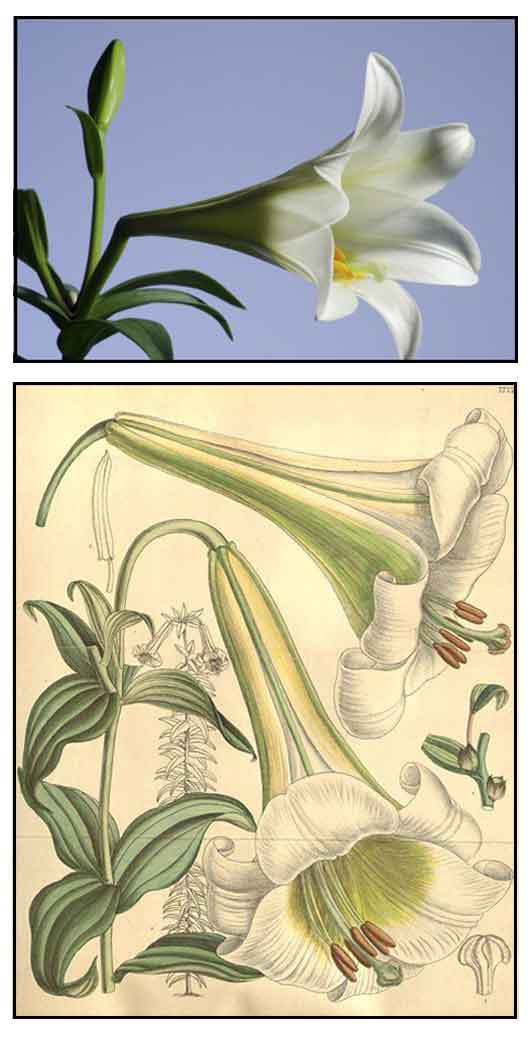 Botany Botany
Lilium longiflorum is bulbous herb about 90 centimeters high. Stems are erect, unbranched and green. Leaves are alternate, simple, sessile, linear-lanceolate, up to 15 centimeters long. Flowers are trumpet-shaped, fragrant and showy. Corolla is white with a light purple streak on the outside; pollen is yellow.
Distribution
- On open grassy slopes.
- Cultivated in Batangas, Baguio and the Mountain Province and other highly elevated areas.
Constituents
- Bulbs are a rich source of steroidal glycosides and polyphenols.
- Studies have isolated steroidal saponins and alkaloids.
- Lipid peroxidation and cyclooxygenase enzyme inhibitory assays found kaempferol (1), kaempferol glycosides (2, 3, 4, 8, 9 and 10), quercetin glycosides (5, 6, and 7), a regaloside (11), a chalcone (12) and a fatty acid fraction (13.) (see study below) (7)
- Study isolated a novel acetylated steroidal glycoalkaloid and two novel steroidal furostanol saponins, along with three other steroidal glycosides from the bulbs.
The flower buds yielded the highest concentration of total steroidal glycosides. Highest concentration of steroidal glycoalkaloids were in the flower buds, leaves, and bulbs. (see study below) (12)
- The highest concentrations of total five steroidal glycosides were 12.02 ± 0.36, 10.09 ± 0.23, and 9.36 ± 0.27 mg/g dry weight in flower buds, lower stems, and leaves, respectively. The highest concentrations of two steroidal glycoalkaloids were 8.49 ± 0.3, 6.91 ± 0.22, and 5.83 ± 0.15 mg/g dry weight in flower buds, leaves, and bulbs, respectively. Highest concentrations of three furostanol saponins were 4.87 ± 0.13, 4.37 ± 0.07, and 3.53 ± 0.06 mg/g dry weight in lower stems, fleshy roots, and flower buds, respectively. (17)
Properties
- Bulb is considered anti-asthmatic, antitussive, expectorant, sedative and tonic.
- Studies have shown hepatoprotective, antioxidant, anticancer, hypoglycemic, hypolipidemic properties.
Parts used
Bulb.
Uses
Edibility / Culinary
Flowers, leaves, roots are reportedly edible.
Folkloric
- No known folkloric medicinal use in the Philippines.
- Elsewhere, the bulb reported to be used for coughs, hemoptysis, insomnia.
Others
- Perfumery: Essential oil from the flowers used in perfumery.
Studies
• Phenolic Glycosides: Three bitter principles were isolated from the bulb scales of Lilium longiflorum. (2)
• Anti-Cancer / Cytotoxic: Preliminary studies have shown the extracts from bulbs to be significantly cytotoxic to MCF-7 breast cancer cells and HL-60 leukemia cells. Study yielded steroidal glycosides, two of which are steroidal glycoalkaloids, three are furostanols.
• Hypoglycemic / Hypolipidemic / Bulbs: Study isolated steroidal glycosides from an extract from the bulbs of Lilium longiflorum that reduced blood glucose and body weight in lab mice on a high fat diet. Study is on-going to confirm or identify the active ingredients with hypoglycemic and hypolipidemic effects in the mouse model. (5)
• COX-1 Inhibition / Lipid Peroxidation Inhibition: Lipid peroxidation and cyclooxygenase enzyme inhibitory assays found kaempferol (1), kaempferol glycosides (2, 3, 4, 8, 9 and 10), quercetin glycosides (5, 6, and 7), a regaloside (11), a chalcone (12) and a fatty acid fraction (13.) Compound 1 showed the highest COX-1 inhibition (94.1%) followed by 3, 8, and 12. Results suggest kaempferol and quercetin flavonoids contribute to the medicinal properties of Easter lily flowers. (7)
• Hepatoprotective / Bulbs: Study evaluated a hydroalcoholic crude bulb extract (CB) and a steroidal glycoside-rich 1-butanol extract prepared from bulbs of Easter lily for hepatoprotective activities in a type 2 diabetic mouse model. Results suggest steroidal glycosides 1-5 may play a role in the hepatoprotective activity of the BuOH extracts, while TC measurements and OGTT results suggest that other constituents in the CB extract are responsible for hypocholesterolemic and hypoglycemic activity. (8)
• Ginseng Essence / Hepatoprotective: Lilium longiflorum is one of four medicinal and edible herbs (Panax ginseng, Panax quinquefolius, Nelumbo nucifera) in formulation called Ginseng Essence (GE). Study evaluating the hepatoprotective effect of GE in CCl4-induced liver inflammation and fibrosis Wistar rats showed amelioration of AST and ALT elevations and albumin decline through attenuation of oxidative stress. (9)
• Antifungal Against Plant Pathogens: Study isolated a novel acetylated steroidal glycoalkaloid and two novel steroidal furostanol saponins, along with three other steroidal glycosides from the bulbs. Purified steroidal glycosides showed weak fungal growth inhibition against plant pathogenic fungus, Botrytis cinerea. Natural acetylation of the steroidal glycoalkaloid increased the antifungal activity by inhibiting the rate of metabolism of the compound by the fungus. A model system was developed that led to the discovery of several new fungal metabolites. (see constituents above) (12)
• Toxicity / Poisoning in Cats: Easter lilies (Lilium longiflorum), tiger lilies (L. tigrinum) and Japanese showy lilies (L. speciosum and L. lancifolium) and other members of the Liliaceae family can cause renal failure and death in cats. These studies reproduced the clinical disease, identified the most toxic fraction of Easter lily, characterized the clinical pathology, histopathology and ultrastructural pathology associated with the disease. Results showed only the aqueous extracts of leaves and flowers were nephrotoxic and pancreatoxic.(13) (14) Toxic principle/s and mechanism of lily toxicty is unknown, but renal damage is due to necrosis of the renal tubular epithelial cells, with initial damage to the renal tubular epithelium resulting polyuric renal failure, which results in severe dehydration. All plants parts are considered toxic viz., pollen, flower, stem, and leaves. Prognosis in cats is good if decontamination is prompt and treatment started before renal impairment. (16)
• Occupational Allergy / IgE Mediated Reactions: Study reports on a case of a 35-year old flower supplier who developed IgE-mediated allergic rhinoconjunctivitis with nasal polyps, contact urticaria, and dermatitis after handling Lilium longiflorum, Gysophilia paniculata, and Dianthus caryophillus. Studies showed presence of positive immediate prick tests. Two IgE-binding bands (19 and 22 kDa) were obtained against Lilium longiflorum. Findings suggest IgE-mediated reaction as responsible mechanism for the respiratory and cutaneous symptoms of the patients. (15)
Availability
Wild-crafted.
|

![]()



 Botany
Botany